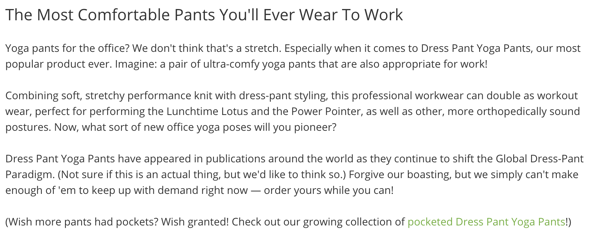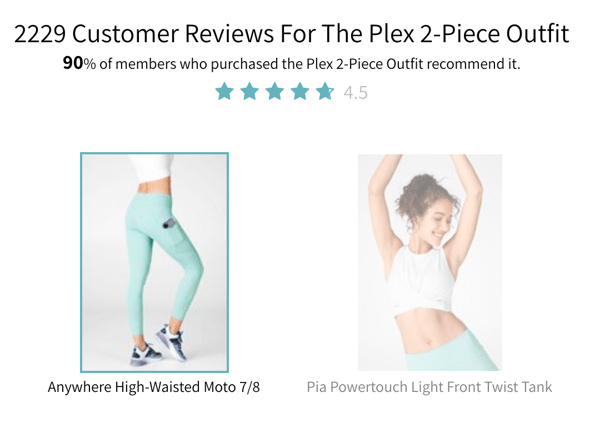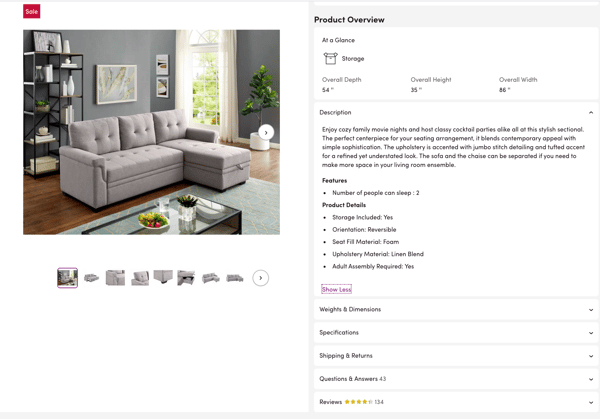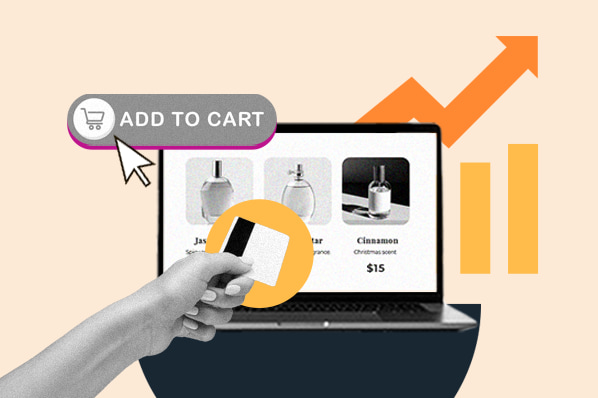I'll admit it -- I love online shopping. Recently, I've been shopping online more than ever.

And I'm not the only one.
In fact, last year annual online sales were over $3 billion. In 2020, online sales are projected to reach $4.2 billion.
That's why product descriptions are more important than ever.
As a marketer, it might be time to rewrite your product descriptions to increase online sales.
Below, let's review what a product description is and how to write one. Then, to help guide your own writing process, we'll look at some examples and templates to get you started.
What is a product description?
A product description is the copy that's written on a product page explaining what a product is and why you should purchase it. The goal of the description is to describe the value of a product so online visitors are convinced to purchase it.
Usually, a product description will include product details. Additionally, it should tell a story about how the product can solve the target audience's pain points. If a visitor can't imagine themselves benefiting from a product, they won't purchase it.
How to Write a Product Description
- Consider your buyer persona.
- Get creative.
- Use details.
- Optimize for SEO.
- Include social proof.
- Make it easy to read.
- Incorporate graphics and images.
- Measure your success.
1. Consider your buyer persona.
With any copy you write, you need to keep your buyer persona in mind. It's important that your product description is catered to your target audience.
For example, your product description should specifically address pain points and goals of your buyer persona.
Online visitors need to be able to visualize themselves using a product before they'll purchase it.
Additionally, you should use the same language that potential customers use. Doing your keyword research will help you do this (more on that below).
For instance, does your product description use the same humor of your target audience? Does it answer questions they might have?
This is important to keep in mind when you're writing your product descriptions because you want to reduce any barriers or concerns potential customers might have.
2. Get creative.
Any marketing copy you write should be creative. Product descriptions are no different.
Ultimately, your product description should tell a story and sell an experience. Not to reiterate, but visitors need to be able to imagine themselves using the product.
Your product description should let them know what's in it for them. How will they benefit from buying your product?
When you're brainstorming what story to tell, think of what inspired you to create your product, how it was tested, and obstacles you overcame.
Perhaps the answers to these questions are things that align with your buyer persona's values or pain points.
3. Use details.
When you write a product description, you should be as specific as possible. That means you shouldn't use any fluffy or vague language that doesn't add value to the description.
After writing a draft, see if every sentence adds value. For example, does each sentence educate a visitor about either the product or brand? If not, take it out.
Additionally, instead of listing features, you should focus on listing benefits that solve customer pain points. And be detailed about it.
The more details, the more credible the product is.
4. Optimize for SEO.
SEO is extremely important in product descriptions. You want your products to show up when people are shopping online.
To optimize your product descriptions, do keyword research and discover what customers are searching for.
You should use keywords in your page titles, meta descriptions, image alt tags, and product description copy.
Using keywords should make your product easier to find online.
5. Include social proof.
Before anyone makes a purchase nowadays, they look at the reviews online. The better the reviews, the more likely people are to make a purchase.
By including social proof in your product description or on your product page, you're making that step easier.
It's important to reduce the need for a customer to do further research. All the information they need should be on your product page.
Some brands include social proof in the form of a quote. Others just include reviews below the product description. Either way, social proof should be easy to find.
6. Make it easy to read.
Information shouldn't just be easy to find, but it should be easy to digest as well. If you only have one large block of text, visitors aren't going to read that.
Your product description should be easy to scan. You can accomplish this visually and with simple formatting.
For example, use larger headlines, include bullet points, and take advantage of white space. The easier it is to read your description, the more likely visitors are to actually read it.
7. Incorporate graphics and images.
Sometimes you can be tempted to include a long list of bulleted features. However, that might not be the best way to get your message across.
If there's something you want your audience to know that you don't want to include in the text, create a graphic.
You can use symbols or graphics above your product description. For example, if your product is vegan, perhaps you'd want to include the vegan symbol above your product description instead of stating that feature in the description itself.
8. Measure your success.
Once you finish writing your product descriptions, you might have different versions you want to test. If that's the case, don't be afraid to do an A/B test.
You might test different lengths, keywords, or formulas. Testing will help you optimize your descriptions.
Additionally, once you've decided which description is working, you'll want to measure your success.
To do this, choose the metrics you want to track. Is it conversion rate? Cart abandonment rate? Or maybe it's organic rankings?
Whatever you decide, make sure you track your success so you know if your new descriptions are generating revenue.
Product Description Examples
1. Betabrand
Betabrand is known for selling dress yoga pants for women. In their product description below, they used personality to relate to their target audience.
This description is creative and includes important information such as social proof and the benefits of wearing the pants.
Additionally, the last paragraph adds an element of exclusivity to the product, leaning into the FOMO phenomenon.

2. Fabletics
One of the main things that Fabletics does really well is social proof. Below their product descriptions, they include a large graphic that discusses reviews and customer happiness.
They even tell you how many people have reviewed the product and the percentage of people who were happy with it.
The reason this works really well is because it makes the visitor feel like everyone likes the product, so there's no reason not to purchase it.

3. Wayfair
The Wayfair product description is probably the most extensive. Besides the description itself, the product page includes graphics at the top and expandable information at the bottom, including reviews and questions and answers.
Additionally, the product description itself is written really well. It tells a story so the reader can imagine themselves using the product. Plus, the description discusses benefits, while the bullet points review the features.

Product Description Template
Now that you know how to write a product description and you saw some examples, it's time to get started on your own.
While you're brainstorming the content you want to include, answer these questions:
- Who is the product for and what kind of language are they using?
- What are the main benefits of your product?
- How does someone use your product?
- What's the value of your product? Why is it better than competitors?
These answers should give you a good place to start.
Once you have all the information you need, consider using this formula:
- Begin by telling a story and setting the scene (about 1-2 sentences)
- List the benefits of using your product (can be a bulleted list of maybe 3-5 items)
- Finish by including social proof if you can (a quote or award)
All the while, make sure you're sprinkling in details and optimizing for keywords based on your research. Additionally, below your description, you might include reviews or graphics that list out some key features.
Product descriptions are an important element of your product pages. They help tell the story of your product so your visitors can imagine themselves using it.
![→ Download Now: Free Product Marketing Kit [Free Templates]](https://no-cache.hubspot.com/cta/default/53/08b5e1f4-5d26-405b-b986-29c99bd0cb14.png)

![How to Write an Ecommerce Business Plan [Examples & Template]](https://blog.hubspot.com/hubfs/ecommerce%20business%20plan.png)




![How to Send Effective Order Confirmation Emails [Examples + Template]](https://blog.hubspot.com/hubfs/order-confirmation-email-1.jpg)

![How to Start an Ecommerce Business in 2022 [Steps + Must-Follow Tips]](https://blog.hubspot.com/hubfs/how%20to%20start%20an%20ecommerce%20business.jpg)
